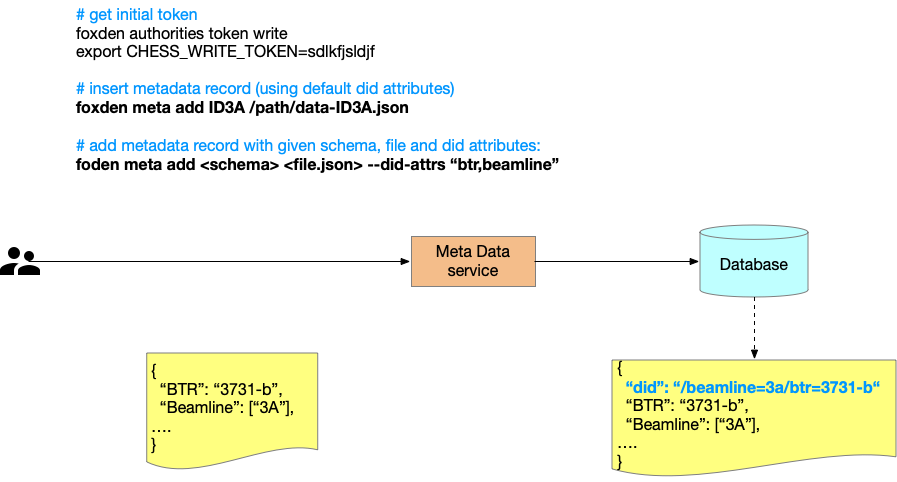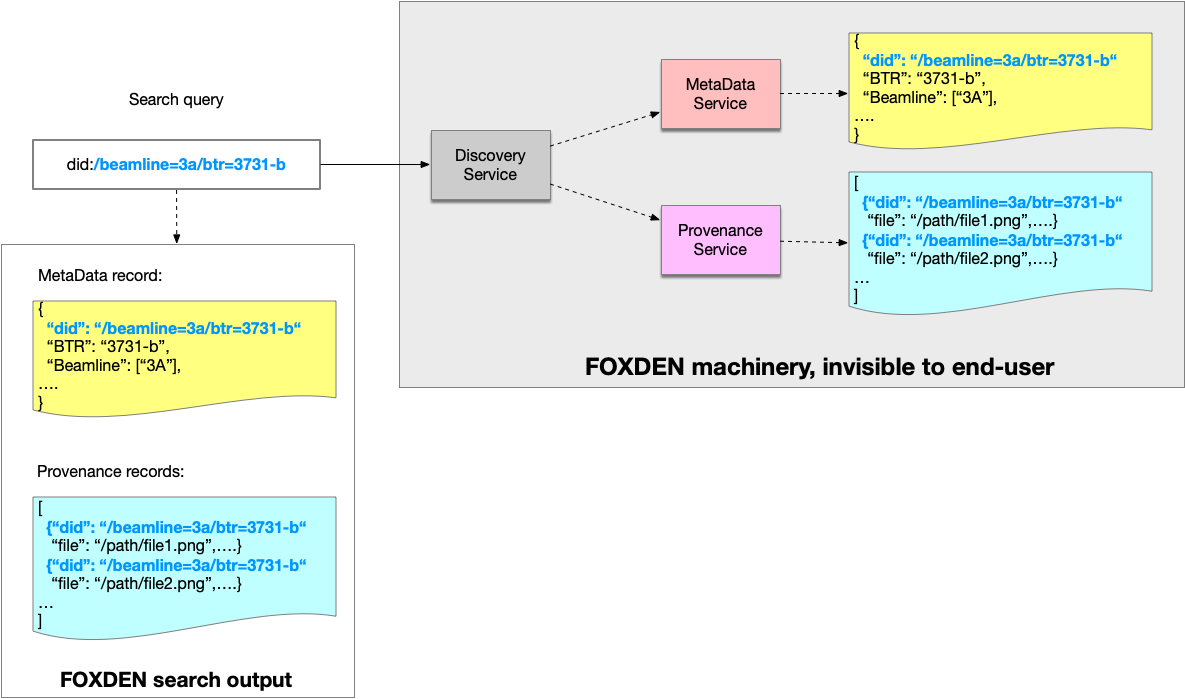Dataset IDentifier
The Dataset IDentifier (DID) is a unique identifier for the CHESS/FOXDEN dataset. It may be represented in two different forms:
- as a JSON record with key-value pairs, for example:
{ "key1": "value1", "key2": "value2", ... } - or, as a human-readable string which is a composition of different key-value
pairs separated by a dedicated character, where their placement follows
alphabetically sorted keys, for example:
/key1=value1/key2=value2/...
Additional constraints:
-
Choice of characters in key-value pairs: We suggest choosing one common notation, for instance, lowercase keys and values, with no empty spaces. If an empty space is required by a value, it should be replaced by an underscore value. Therefore, if the user chooses BTR and Beamline keys to define a dataset, their string representation can be identified as follows:
/beamline=value/btr=value. -
Use the slash character, i.e.,
/, as a separator and the equal character, e.g.,=, as a divider between key and values. The choice of=versus:is preferable since the latter is already used in the MetaData service for query purposes and to avoid possible parsing problems. For example, in MetaData queries, we use:as a separator between key and a value; therefore, parsingdid:/key=valueuser query will be resolved into{"did": "/key=value"}, while parsingdid:/key:valuebecomes difficult to implement due to multiple meanings of a separator.
DID Placement in CHESS/FOXDEN Workflows and Services
The CHESS/FOXDEN dataset becomes live once a new metadata record is recorded in
the MetaData service. At this point, users or user workflows may specify a DID
value, provide a list of attributes to construct it from, or rely on underlying
tools, libraries, or services to use default attributes (e.g., beamline,
btr, cycle, sample).
Each metadata record describes the conditions of a specific experiment and the data collected at CHESS beamlines. These records adhere to a predefined schema and are validated against predefined data types. Thus, we offer a flexible way to define a DID using any set of key-value pairs presented in the metadata record. Therefore, users or user workflows have three possibilities:
- Specify the DID value within the metadata record itself (the corresponding key is
did). - Provide a comma-separated list of attributes to define a DID, e.g.,
key1,key2,.... - Allow the underlying service/tool to use defaults, e.g.,
beamline,btr,cycle,sample.
Here is an example of metadata insertion using foxden command line tool:

Please note that CHESS metadata records follow the CamelCase keys convention, while we suggest using lowercase keys and values in the DID string representation or construction (which will be done by underlying software).
Once the DID is defined and recorded within the metadata record, it will be used in other services such as Provenance, Data Management, SpecScans, and Data Discovery to relate other information to it. For instance, the Provenance service can associate the DID with software versions and lists of files, among other details. The Data Management service will know how to map collections of files or blob chunks into a dataset, while the SpecScans service will provide a mapping between the DID and specific motor positions used during the experiment.
During a lookup via Data Discovery, users can specify the DID to find details about a specific dataset.
Dataset Relationships
The DID format (presented as a series of key-value pairs) provides a flexible format to define derived data and establish necessary relationships between different datasets.
For example, if a raw dataset is defined as:
/aaa=value/bbb=value
then a derived dataset can be identified using the following DID:
/aaa=value/bbb=value/datatier=derived
The derived dataset may or may not have its own metadata record. But it will allow to setup parent child relationship in Provenance service between the two, e.g.
# the dataset
/aaa=value/bbb=value/datatier=derived
# will have parent dataset
/aaa=value/bbb=value
This will allow to setup (complex) finite graph relationships, e.g.
DatasetA -> DatasetB -> DatasetC
\ ^
\ /
\-> DatasetX
# here
# DatasetA is a parent of DatasetB and DatasetX
# DatasetC is a child of DatasetB and DatasetX
In either case, the Data Discovery service can look up the relationship between two dataset DIDs and find out the original metadata record.
Usage of DID in search queries
Here is how we envision the system will work:
- a user place a query to FOXDEN frontend
- the query is sent to Data Discovery service
- the Data Discovery service convert query into spec and send request to FOXDEN services, like MetaData, Provenance, Spec Scan, etc.
- it retrieves results and present them to end-user
- optionally we may add aggregation to final result set and merge them together
Here is pictorial representation of this workflow:

